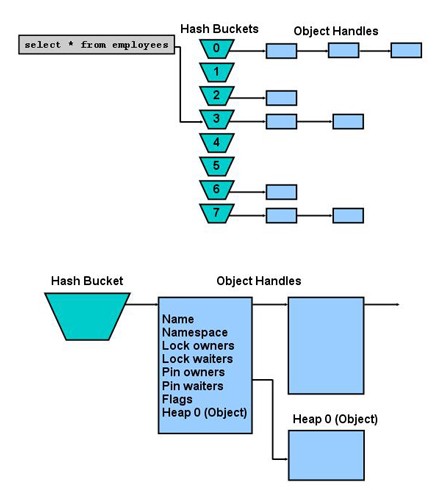一. Library Cache Lock

Library cacheHandle 里保存了lock 和 pin 的信息。而且在Library cache handle 和child cursor 上都有lock 和pin。它们称为library cache lock和library cache pin。
Library cachelock/pin是用来控制对librarycache object的并发访问的。Lock管理并发,pin管理一致性,lock是针对于librarycache handle, 而pin是针对于heap。
当我们想要访问某个library cache object,我们首先要获得这个指向这个object的handle的lock,获得这个lock之后我们就需要pin住指向这个object的heap。
当我们对包,存储过程,函数,视图进行编译的时候,Oracle就会在这些对象的handle上面首先获得一个library cache lock,然后再在这些对象的heap上获得pin,这样就能保证在编译的时候其它进程不会来更改这些对象的定义,或者将对象删除。
当一个session对SQL语句进行硬解析的时候,这个session就必须获得librarycache lock,这样其他session就不能够访问或者更改这个SQL所引用的对象。如果这个等待事件花了很长时间,通常表明共享池太小(由于共享池太小,需要搜索free的chunk,或者将某些可以被移出的object page out,这样要花很长时间),当然了,也有可能另外的session正在对object进行修改(比如split 分区),而当前session需要引用那个table,那么这种情况下我们必须等另外的session进行完毕。
Library Cache lock有3中模式:
(1)Share(S): 当读取一个library cache object的时候获得
(2)Exclusive(X): 当创建/修改一个library cache object的时候获得
(3)Null(N): 用来确保对象依赖性
比如一个进程想要编译某个视图,那么就会获得一个共享锁,如果我们要create/drop/alter某个对象,那么就会获得exclusive lock。Null锁非常特殊,我们在任何可以执行的对象(cursor,function)上面都拥有NULL锁,我们可以随时打破这个NULL锁,当这个NULL锁被打破了,就表示这个对象被更改了,需要从新编译。
NULL锁主要的目的就是标记某个对象是否有效。比如一个SQL语句在解析的时候获得了NULL 锁,如果这个SQL的对象一直在共享池中,那么这个NULL锁就会一直存在下去,当这个SQL语句所引用的表被修改之后,这个NULL锁就被打破了,因为修改这个SQL语句的时候会获得Exclusive 锁,由于NULL锁被打破了,下次执行这个SQL的时候就需要从新编译。
Library Cache pin有2种模式:
(1)Share(S): 读取object heap
(2)Exclusive(X): 修改object heap
当某个session想要读取object heap,就需要获得一个共享模式的pin,当某个session想要修改object heap,就需要获得排他的pin。当然了在获得pin之前必须获得lock。
在Oracle10gR2中,library cache pin被library cache mutex 所取代。
Library cache latch用来控制对library cache object的并发访问。前面已经提到,我们要访问library cacheobject之前必须获得librarycache lock, lock不是一个原子操作(原子操作就是在操作程中不会被打破的操作,很明显这里的lock可以被打破), Oracle为了保护这个lock,引入了library cache latch机制,也就是说在获得library cachelock之前,需要先获得library cache latch,当获得library cache lock之后就释放librarycache latch。
如果某个librarycache object没有在内存中,那么这个lock就不能被获取,这个时候需要获得一个library cache load lock latch,然后再获取一个librarycache load lock,当load lock获得之后就释放library cache load lock latch。
librarycache latch受隐含参数_KGL_LATCH_COUNT的控制,默认值为大于等于系统中CPU个数的最小素数,但是Oracle对其有一个硬性限制,该参数不能大于67。
注意:我们去查询_kgl_latch_count有时候显示为0,这是一个bug。
Oracle利用下面算法来确定library cache object handle是由哪个子latch来保护的:
latch#= mod(bucket#, #latches)
也就是说用哪个子latch去保护某个handle是根据那个handle所在的bucket号,以及总共有多少个子latch来进行hash运算得到的。
MOS 的文档【122793.1】里说导致librarycache lock通常有2种原因:
(1)A DML operation that is hangingbecause the table which is accessed is currently undergoing changes (ALTERTABLE). This may take quite a long time depending on the size of the table andthe type of the modification (e.g. ALTER TABLE x MODIFY (col1 CHAR(200) on atable with thousands of records)
In this case,V$LOCK will show that the session doing the 'ALTER TABLE' with an exclusive DMLenqueue lock on the table object (LMODE=6, TYPE=TM where ID1 is the OBJECT_IDof the table). The waiting session however does not show up in V$LOCK yet so inan environment with a lot of concurrent sessions the V$LOCK information will beinsufficient to track down the culprit blocking your operation.
(2)The compilation of package willhang on Library Cache Lock and Library Cache Pin if any users are executing aprocedure/function defined in the same package.
更多内容参考:
http://blog.csdn.net/tianlesoftware/article/details/6629869
OracleLibrary Cache 的lock 与 pin 说明
http://blog.csdn.net/tianlesoftware/article/details/6641440
http://blog.csdn.net/tianlesoftware/article/details/6624122
http://blog.csdn.net/tianlesoftware/article/details/6638899
二. 处理Library cache lock
2.1 使用hanganalyze + systemstat 分析
Systemstat 事件包含每个oracle 进程的详细信息。当操作hang住时,可以新开一个窗口,使用该事件,捕获相关信息。
Systemdump 级别说明:
LEVEL参数:
10 Dump all processes (IGN state)
5 Level 4 + Dump all processes involved in wait chains (NLEAF state)
4 Level 3 + Dump leaf nodes (blockers) in wait chains(LEAF,LEAF_NW,IGN_DMP state)
3 Level 2 + Dump only processes thought to be in a hang (IN_HANG state)
1-2 Only HANGANALYZE output, no process dump at all
level 266= SYSTEM STATE (level=10, withshort stacks) = level 10 + short stacks
level 266 在level 10的基础上包含了进程的short stacks信息
Oracle 9.2.0.1 之后,执行如下脚本:
$sqlplus '/ as sysdba'
oradebugs etmypid
oradebug unlimit
oradebug dump systemstate 266
oradebug tracefile_name
systemstat 226级别在9.2.0.6 之前不可用,所以在之前的版本可以使用如下命令:
alter session set max_dump_file_size=unlimited;
alter session set events 'immediate trace name systemstate level 10'
先执行hanganalyze,如下:
SQL> oradebug setmypid
SQL>oredebug unlimit
SQL> oradebug setinst all
SQL> oradebug -g def hanganalyze 3;
SQL>oradebug tracefile_name
如下文件里其他session都被1169的阻塞:
State of ALL nodes
([nodenum]/cnode/sid/sess_srno/session/ospid/state/[adjlist]):
[1001]/1/1002/9/c00000063d7aff78/9720/NLEAF/[1169]
[1159]/1/1160/51635/c00000063d8dfc68/19539/NLEAF/[1169]
[1160]/1/1161/15627/c000000631959658/8818/NLEAF/[1169]
[1162]/1/1163/27931/c0000006398d7810/20170/NLEAF/[1169]
[1165]/1/1166/4003/c0000006358f4d58/22069/NLEAF/[1169]
[1166]/1/1167/45511/c0000006398d4868/15674/NLEAF/[1169]
[1167]/1/1168/46253/c00000063d8d9d18/29492/NLEAF/[1169]
[1169]/1/1170/9233/c0000006358f1db0/9434/LEAF_NW/
[1170]/1/1171/43901/c0000006398d18c0/13246/NLEAF/[1169]
[1171]/1/1172/53701/c00000063d8d6d70/13794/NLEAF/[1169]
[1172]/1/1173/23737/c000000631950760/25188/NLEAF/[1169]
[1173]/1/1174/28801/c0000006358eee08/24770/NLEAF/[1169]
[1175]/1/1176/25017/c00000063d8d3dc8/18795/NLEAF/[1169]
[1177]/1/1178/3/c0000006358ebe60/10170/NLEAF/[1169]
这里sess_srno 是v$session 中的serial#.
Ospid 是系统进程号。
找到了sid和serial# 就可以查看对应session 的信息,是什么操作。 如果session 没有sql_id, 那么可以进一步使用oradebug systemdump 对应的进程。 来查看信息。
SYS@dave2(db2)> oradebug setospid 9434
Oracle pid: 18, Unix processpid: 27028, image: oracledave2@db2
SYS@dave2(db2)> oradebug unlimit
Statement processed.
SYS@dave2(db2)> oradebug dump systemstate 10
Statement processed.
SYS@dave2(db2)> oradebug TRACEFILE_NAME
/u01/app/oracle/admin/dave2/udump/dave2_ora_27028.trc
SYS@dave2(db2)> oradebug close_trace
Statement processed.
然后使用awk来分析systemdump 的trace:
Oracle 使用ass.awk 工具查看system state dump 说明
http://blog.csdn.net/tianlesoftware/article/details/7237729
这里也可以直接用systemdump 查看所有的进程信息。
2.2 查看X$KGLLK表
The X$KGLLK table (accessibleonly as SYS/INTERNAL) contains all the library object locks (both held &requested) for all sessions and is more complete than the V$LOCK view althoughthe column names don't always reveal their meaning.
--X$KGLLK 表只能被SYS/INTERNAL用户访问,其包含所有library object locks的信息(held和requested)。
--查看等待事件为librarycache lock的session 的session address (SADDR):
SQL>select sid,saddr from v$session where event='library cache lock';
SID SADDR
---------- --------
16 572ed244
--从x$kgllk查看具体的锁信息:
select kgllkhdl Handle, kgllkreq Request,kglnaobj Object
from x$kgllk
where kgllkses = '572ed244'
and kgllkreq > 0;
HANDLE REQUEST OBJECT
-------- ---------- -------------------
62d064dc 2EMPLOYEES
KGLLKREQ: This will show you the library cache lock requested by this session(KGLLKREQ > 0)
KGLNAOBJ:contains the first 80 characters of the name of the object.
KGLLKHDL:corresponds with the 'handle address' of the object
--然后根据KGLLKHDL从X$KGLLK查看KGLLKMOD > 0的session,其正在持有该锁:
select kgllkses saddr, kgllkhdl handle,kgllkmod mod, kglnaobj object
from x$kgllk lock_a
where kgllkmod > 0
andexists (select lock_b.kgllkhdl
from x$kgllk lock_b
where kgllkses = '572ed244'/* blocked session*/
and lock_a.kgllkhdl =lock_b.kgllkhdl
and kgllkreq > 0);
SADDR HANDLE MOD OBJECT
-------- ----------- ------- --------
572eac94 62d064dc 3 EMPLOYEES
--查看所有blocked的session:
selectsid, username,terminal, program
from v$session
where saddr in
(select kgllkses
from x$kgllk lock_a
where kgllkreq > 0
andexists (select lock_b.kgllkhdl
from x$kgllk lock_b
where kgllkses = '572eac94'/* blocking session*/
and lock_a.kgllkhdl =lock_b.kgllkhdl
and kgllkreq = 0));
--查看所有持有librarycache pin 或者lock的session 在做什么:
SELECT s.sid, kglpnmod"Mode",kglpnreq "Req", SPID "OS Process"
FROM v$session_wait w,x$kglpn p, v$session s, v$process o
WHERE p.kglpnuse =s.saddr
AND kglpnhdl = w.p1raw
and w.event like'%library cache %'
and s.paddr = o.addr
2.3 处理问题
一般来说,使用2.1 或者2.2 的方法都可以找到library cache lock的根源,确定是哪个session 导致的,如我们上面的hanganalyze中,是1169的session。 我们只需要kill 掉这个session,其他的问题就会自动解决了。
先在DB级别kill session,如果kill 不了,在os 级别kill。
alter systemkill session '1170,9233';
注意在os 级别kill 之前,先用ps 命令查看一下该进程,如果是DB 进程,不可随意kill,否则会导致系统crash。
ps –ef|grep 9434
kill -9 9434
参考:
How to Find which Session is Holding a ParticularLibrary Cache Lock [ID 122793.1]
from:http://blog.csdn.net/tianlesoftware/article/details/7956996
























 585
585

 被折叠的 条评论
为什么被折叠?
被折叠的 条评论
为什么被折叠?








